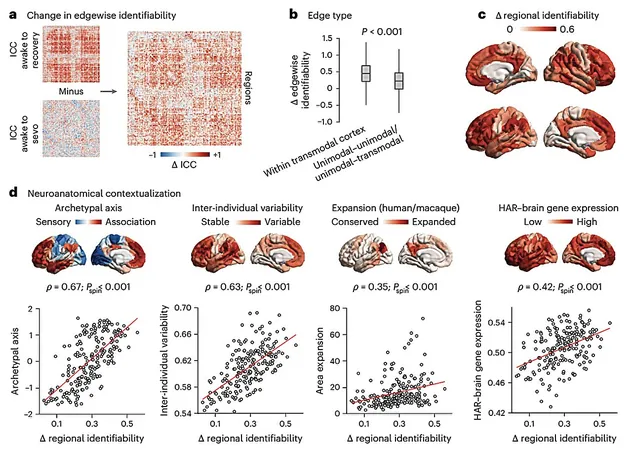
Mind Under Anesthesia: How General Anesthesia Blurs Brain Identity
2025-04-09
Author: Daniel
Unlocking the Secrets of Our Unique Brain Patterns
Have you ever wondered what makes your brain uniquely yours? Past studies show that each individual's brain reflects characteristic patterns of thoughts, emotions, and behaviors, creating distinct neural identities—what scientists refer to as 'brain fingerprints.' Recently, a groundbreaking study by researchers at McGill University and the University of Cambridge has shed light on how general anesthesia impacts these unique signatures.
The Study: A Deep Dive into Anesthesia's Effects
Published in the journal *Nature Human Behavior*, the research reveals that general anesthesia lessens the unique functional connectivity patterns in our brains. This is significant because these connectivity patterns dictate how different brain regions communicate with each other.
"Every person is unique in how they think and feel. This uniqueness stems from our brain's intricate connections," said Andrea Luppi, the study's lead author. "But during moments of unconsciousness—like those induced by general anesthesia—the essence of our individuality seems to fade. Our team set out to explore what happens to these brain fingerprints during such states of artificial sleep."
Methodology: Imaging Our Unconscious Minds
To unravel these complexities, the researchers used functional magnetic resonance imaging (fMRI), a tool that allows scientists to observe brain activity by monitoring blood flow. They conducted scans of healthy individuals before anesthesia, during unconsciousness, and after consciousness was restored.
"We aimed to measure 'functional connectivity' to create these brain fingerprints and analyze how distinguishable individuals remained under anesthesia," Luppi explained.
Shocking Findings: Anesthesia Equals Loss of Identity?
The results were startling. When participants were under anesthesia, their neural activity became so suppressed that it became challenging to differentiate one person from another based solely on their brain activity—a stark contrast to when they were conscious.
Luppi noted, "While conscious, brain fingerprints can easily distinguish individuals, but this uniqueness diminishes under anesthesia. The effects are most pronounced in areas of the brain that are distinctly human and contribute to our self-awareness."
Implications for Future Research
This intriguing study opens doors for further research into how anesthesia impacts brain connectivity across various species. Such investigations could lead to innovative approaches for aiding recovery in both humans and animals after procedures requiring anesthesia.
Luppi expressed excitement about future cross-species studies, stating, "Anesthesia is remarkably consistent across species. By understanding how it interacts with the brain, we might glean insights into reviving consciousness in patients who face long-term unconsciousness following traumatic brain injuries."
The Bottom Line: A New Understanding of Consciousness
This research not only challenges our view of identity under anesthesia but also holds promise for enhancing recovery strategies for those afflicted by neurological challenges. As we continue to explore the nuances of consciousness and the brain, the path to recovery could become clearer than ever.


 Brasil (PT)
Brasil (PT)
 Canada (EN)
Canada (EN)
 Chile (ES)
Chile (ES)
 Česko (CS)
Česko (CS)
 대한민국 (KO)
대한민국 (KO)
 España (ES)
España (ES)
 France (FR)
France (FR)
 Hong Kong (EN)
Hong Kong (EN)
 Italia (IT)
Italia (IT)
 日本 (JA)
日本 (JA)
 Magyarország (HU)
Magyarország (HU)
 Norge (NO)
Norge (NO)
 Polska (PL)
Polska (PL)
 Schweiz (DE)
Schweiz (DE)
 Singapore (EN)
Singapore (EN)
 Sverige (SV)
Sverige (SV)
 Suomi (FI)
Suomi (FI)
 Türkiye (TR)
Türkiye (TR)
 الإمارات العربية المتحدة (AR)
الإمارات العربية المتحدة (AR)